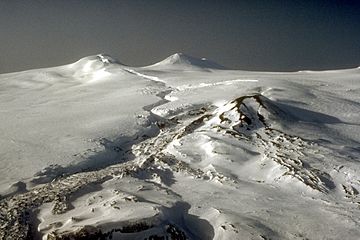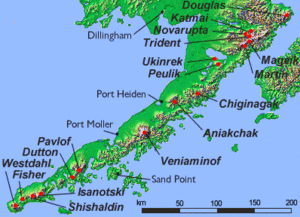Mount Westdahl facts for kids
Quick facts for kids Mount Westdahl |
|
|---|---|

Summit area of Westdahl volcano, February 1993
|
|
| Highest point | |
| Elevation | 5,426 ft (1,654 m) |
| Geography | |
| Location | Unimak Island, Alaska |
| Parent range | Aleutian Range |
| Topo map | USGS Unimak C-2 |
| Geology | |
| Mountain type | Stratovolcano |
| Volcanic arc/belt | Aleutian Arc |
| Last eruption | 1991 to 1992 |
Mount Westdahl is a tall, active volcano located in the state of Alaska, United States. It is part of the Aleutian Range, a long chain of mountains and volcanoes. This mountain is known for its impressive height and its history of eruptions.
About Mount Westdahl
Mount Westdahl is a type of volcano called a stratovolcano. These volcanoes are also known as composite volcanoes. They are shaped like a cone and are built up over time. This happens from many layers of hardened lava, volcanic ash, and rocks.
Stratovolcanoes often have steep slopes and a crater at the top. They can produce explosive eruptions. Mount Westdahl stands tall at 5,426 feet (1,654 meters) above sea level.
Where is Mount Westdahl?
Mount Westdahl is found on Unimak Island. This island is located near the very end of the Alaska Peninsula. Unimak Island is the largest island in the Aleutian Islands chain. This chain stretches out into the Pacific Ocean.
The volcano is part of the Aleutian Arc. This is a curve of volcanoes formed where two of Earth's tectonic plates meet. The Pacific Plate is sliding under the North American Plate here. This process creates magma, which then rises to form volcanoes like Westdahl.
Eruptions of Westdahl
Mount Westdahl is an active volcano. This means it has erupted in recent history or is expected to erupt again. Its most recent known eruption happened between 1991 and 1992.
Volcanic eruptions can release lava, ash, and gases. Scientists carefully watch active volcanoes like Westdahl. They use special tools to detect changes that might signal an upcoming eruption. This helps keep people safe.
Images for kids



